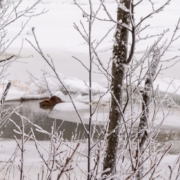Brrr…How do they Survive?
Winter and Wildlife
You’ve probably seen the meme of the cougar looking in through the patio door. It says, “If you’re cold, they’re cold, bring them inside.” Of course, the meme is meant to make you laugh, but then you think about all those poor animals, braving -40 C, sometimes for weeks on end and it’s really quite amazing.
Beaver having a snack in the North Saskatchewan River in -23° C weather. Photo ©KRSchwengler.
Not only are freezing temperatures a problem, but Alberta’s animals must deal with snow and limited food supplies. For the animals that neither hibernate nor migrate, adapting to winter conditions through behavior and physiology is the answer.
In cold climate animals, shorter daylight hours trigger a gland in the brain called the hypothalamus to cause changes in their behaviour or appearance. Fur grows in thicker and may change colour, wild animals eat more to build up fat reserves, etc. Some even prepare food caches in autumn to help them through winter (beavers and red squirrels).
For birds, winter behavior may include huddling together in groups, fluffing up their feathers to create insulating air spaces and resting in tree cavities. Burrowing in snow may also be an option. Ruffed grouse actually plunge deep into powdery snow, using the insulating properties of the snow to keep them warm. They actually have higher survival rates during winters with more snowfall. Alberta’s grouse species grow extensions on their feet in the autumn to help them stay “afloat” too!
What’s Going On Under the Snow?
 Beautiful drawing by Kristin Illustration depicts life under the snow, www.kristinillustration.com.
Beautiful drawing by Kristin Illustration depicts life under the snow, www.kristinillustration.com.
Wolves and coyote feet are adapted with fleshy pads high in fat. Those pads have the arteries and veins arrayed in such a way that warm blood from the arteries circulates in parallel with the cold blood coming back through the veins, heating it as it heads back up the leg. This tight arrangement of blood vessels explains why they can spend hours on ice and snow.
The more we learn about our wild neighbors, the more amazing they are! Take a walk this winter and marvel at the animals you meet and the amazing adaptations that allow them to thrive in our Alberta winters!



